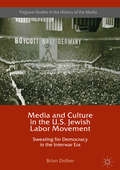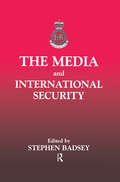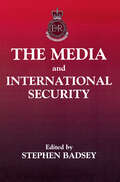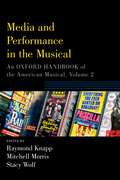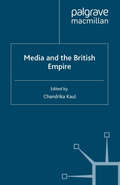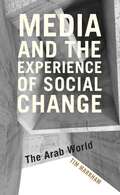- Table View
- List View
Media and Culture in the U.S. Jewish Labor Movement: Sweating for Democracy in the Interwar Era
by Brian DolberThis book explores the Jewish Left’s innovative strategies in maintaining newspapers, radio stations, and educational activities during a moment of crisis in global democracy. In the wake of the First World War, as immigrant workers and radical organizations came under attack, leaders within largely Jewish unions and political parties determined to keep their tradition of social unionism alive. By adapting to an emerging media environment dependent on advertising, turn-of-the-century Yiddish socialism morphed into a new political identity compatible with American liberalism and an expanding consumer society. Through this process, the Jewish working class secured a place within the New Deal coalition they helped to produce. Using a wide array of archival sources, Brian Dolber demonstrates the importance of cultural activity in movement politics, and the need for thoughtful debate about how to structure alternative media in moments of political, economic, and technological change.
Media and Culture in the U.S. Jewish Labor Movement: Sweating for Democracy in the Interwar Era
by Brian DolberThis book explores the Jewish Left’s innovative strategies in maintaining newspapers, radio stations, and educational activities during a moment of crisis in global democracy. In the wake of the First World War, as immigrant workers and radical organizations came under attack, leaders within largely Jewish unions and political parties determined to keep their tradition of social unionism alive. By adapting to an emerging media environment dependent on advertising, turn-of-the-century Yiddish socialism morphed into a new political identity compatible with American liberalism and an expanding consumer society. Through this process, the Jewish working class secured a place within the New Deal coalition they helped to produce. Using a wide array of archival sources, Brian Dolber demonstrates the importance of cultural activity in movement politics, and the need for thoughtful debate about how to structure alternative media in moments of political, economic, and technological change.
Media and Identity in Africa (International African Seminars)
by Kimani Njogu John MiddletonStudies of the media in Africa, incorporating both African and international perspectives, are few. The thirty papers collected here were presented at a seminar organised and hosted by the Kenya-based Twaweza Communications and the International African Institute in Nairobi in 2004. They demonstrate how media outlets are used to perpetuate, question or modify the unequal power relations between the North and the South. Focusing on east Africa, the papers include discussions of the construction of old and new social entities, as defined by class, gender, ethnicity, political and economic differences, wealth, poverty, cultural behaviour, language and religion.The authors illustrate how there is increasing control by local people of traditional and modern forms of media. Globalization is being countered by local responses, within the context of social and cultural identities. Essentially, the book describes the tensions between the global and the local, tensions not often discussed in media studies, thus pioneering new debates.
The Media and International Security (The Sandhurst Conference Series)
by Stephen BadseyA collection of the papers from the 1995 Sandhurst conference presented by leading members of the armed forces, the media and academia. The conference marked a major advance in British thinking on this very topical and fast-moving subject, bringing together authorities from various fields in a multidisciplinary investigation which has been, and will be of great interest to a wide variety of specialist readers.
The Media and International Security (The Sandhurst Conference Series #Vol. 1)
by Stephen BadseyA collection of the papers from the 1995 Sandhurst conference presented by leading members of the armed forces, the media and academia. The conference marked a major advance in British thinking on this very topical and fast-moving subject, bringing together authorities from various fields in a multidisciplinary investigation which has been, and will be of great interest to a wide variety of specialist readers.
Media and Memory in New Shanghai: Western Performances of Futures Past (Palgrave Macmillan Memory Studies)
by A. LagerkvistContributing to current debates about the globality and mediatisation of memories, Media and Memory in New Shanghai interrogates the city's spectacular regeneration into an emergent world centre, describing how Western elites partake in the production of New Shanghai by feeling its futures and performing its futures past.
Media and Nation Building in Twentieth-Century India: Life and Times of Ramananda Chatterjee
by Kalyan ChatterjeeThis book profiles twentieth-century India through the life and times of Ramananda Chatterjee – journalist, influencer, nationalist. Through a reconstruction of his history, the book highlights the oft-forgotten role of media in the making of the idea of India. It shows how early twentieth-century colonial India was a curious melee of ideas and people – a time of rising nationalism, as well as an influx of Western ideas; of unprecedented violence and compelling non-violence; of press censorship and defiant journalism. It shows how Ramananda Chatterjee navigated this world and went beyond the traditional definition of the nation as an entity with fixed boundaries to anticipate Benedict Anderson and Ernest Gellner. The volume also examines the wide reach and scope of his journals in English, Hindi and Bengali, which published the likes of Rabindranath Tagore, Subhash Bose, Abanindranath Tagore, Nandalal Bose, Ananda Coomaraswamy, the scientist J. C. Bose and Zhu Deh, the co-founder of the Chinese Red Army. He also published India in Bondage by the American Unitarian minister J. T. Sunderland, which resulted in his arrest. An intriguing behind-the-scenes look of early twentieth-century colonial India, this book will be of great interest to scholars and researchers of history, modern South Asia and media and cultural studies.
Media and Nation Building in Twentieth-Century India: Life and Times of Ramananda Chatterjee
by Kalyan ChatterjeeThis book profiles twentieth-century India through the life and times of Ramananda Chatterjee – journalist, influencer, nationalist. Through a reconstruction of his history, the book highlights the oft-forgotten role of media in the making of the idea of India. It shows how early twentieth-century colonial India was a curious melee of ideas and people – a time of rising nationalism, as well as an influx of Western ideas; of unprecedented violence and compelling non-violence; of press censorship and defiant journalism. It shows how Ramananda Chatterjee navigated this world and went beyond the traditional definition of the nation as an entity with fixed boundaries to anticipate Benedict Anderson and Ernest Gellner. The volume also examines the wide reach and scope of his journals in English, Hindi and Bengali, which published the likes of Rabindranath Tagore, Subhash Bose, Abanindranath Tagore, Nandalal Bose, Ananda Coomaraswamy, the scientist J. C. Bose and Zhu Deh, the co-founder of the Chinese Red Army. He also published India in Bondage by the American Unitarian minister J. T. Sunderland, which resulted in his arrest. An intriguing behind-the-scenes look of early twentieth-century colonial India, this book will be of great interest to scholars and researchers of history, modern South Asia and media and cultural studies.
Media and Nostalgia: Yearning for the Past, Present and Future (Palgrave Macmillan Memory Studies)
by K. NiemeyerMedia and Nostalgia is an interdisciplinary and international exploration of media and their relation to nostalgia. Each chapter demonstrates how nostalgia has always been a media-related matter, studying also the recent nostalgia boom by analysing, among others, digital photography, television series and home videos.
Media and Peace in the Middle East: The Role of Journalism in Israel-palestine (PDF)
by G. TiripelliIn exploring the dynamics and narratives of peace in journalism, this book explains the media's impact on the transformation of the conflict between Israelis and Palestinians. It discusses the perspectives of peace activists who have been involved in grassroots action since the first Intifada, and examines how their relation with the mainstream media has evolved over time. It compares these views with those of professional journalists who have been covering the conflict, and their sense of the difficulties inherent in practicing a different kind of journalism. The interviews included in this study contribute towards the model of Peace Journalism, with a view to facilitating its successful application to this conflict.
Media and Performance in the Musical: An Oxford Handbook of the American Musical, Volume 2 (Oxford Handbooks)
by Raymond Knapp, Mitchell Morris and Stacy WolfFor the past several years, the American musical has continued to thrive by reflecting and shaping cultural values and social norms, and even commenting on politics, whether directly and on a national scale (Hamilton) or somewhat more obliquely and on a more intimate scale (Fun Home). New stage musicals, such as Come from Away and The Band's Visit, open on Broadway every season, challenging conventions of form and content, and revivals offer audiences a different perspective on extant shows (Carousel; My Fair Lady). Television musicals broadcast live hearken back to 1950s television's affection for musical theatre and aim to attract new audiences through the accessibility of television. Film musicals, including Les Misérables and Into the Woods, capitalize on the medium's technical capabilities of perspective and point of view, as well as visual spectacle. Television has embraced the genre anew, and with unexpected gusto, not only devising musical episodes for countless dramatic and comedy series, but also generating musical series such as Galavant and Crazy Ex-Girlfriend. And animated musicals, such as Disney's Moana, hail child and adult audiences with their dual messages, vibrant visual vocabulary, and hummable music. The chapters gathered in this book, Volume II of the reissued Oxford Handbook, explore the American musical from the various media in which musicals have been created to the different components of a musical and the people who do the work to bring a musical to life.
Media and Performance in the Musical: An Oxford Handbook of the American Musical, Volume 2 (Oxford Handbooks)
For the past several years, the American musical has continued to thrive by reflecting and shaping cultural values and social norms, and even commenting on politics, whether directly and on a national scale (Hamilton) or somewhat more obliquely and on a more intimate scale (Fun Home). New stage musicals, such as Come from Away and The Band's Visit, open on Broadway every season, challenging conventions of form and content, and revivals offer audiences a different perspective on extant shows (Carousel; My Fair Lady). Television musicals broadcast live hearken back to 1950s television's affection for musical theatre and aim to attract new audiences through the accessibility of television. Film musicals, including Les Misérables and Into the Woods, capitalize on the medium's technical capabilities of perspective and point of view, as well as visual spectacle. Television has embraced the genre anew, and with unexpected gusto, not only devising musical episodes for countless dramatic and comedy series, but also generating musical series such as Galavant and Crazy Ex-Girlfriend. And animated musicals, such as Disney's Moana, hail child and adult audiences with their dual messages, vibrant visual vocabulary, and hummable music. The chapters gathered in this book, Volume II of the reissued Oxford Handbook, explore the American musical from the various media in which musicals have been created to the different components of a musical and the people who do the work to bring a musical to life.
Media and Politics in Latin America: Globalization, Democracy and Identity (International Library of Political Studies)
by Carolina MatosLatin America is an increasingly important geopolitical entity and its nations are emerging as some of the most influential and radical states in the modern world. The media conglomerates which control the television and radio platforms in these countries, such as the powerfulGlobo organization in Brazil and the Mercurial S.P.A. media corporation in Chile, have greatpolitical influence across the region. Since the 1980s, television stations, radio stations and newspapers in Mexico, Brazil and Argentina have become increasingly important in the state-building process. In this study, Carolina Matos contrasts public service broadcasting in Brazil and Latin America to that in Europe and the UK, engaging with current globalization debates and theories of cultural imperialism.Left-wing political parties now dominate the South and Central American political landscape, enacting large-scale social change which is bolstered by an increasingly strong media presence in the lives of Latin American citizens. Matos examines the role public media has played in the processes of national development, democratization and international dialogue across Latin America, arguing that it can be a powerful tool for political and social inclusion. Placing media platforms in Latin America in their historical and contemporary contexts, Matos compares them to European public and private media outlets as well as addressing the challenges faced in the digital era.As key countries in the region, such as Brazil and Mexico, begin to flex their economic anddemographic muscle, Latin America is an increasingly influential entity in balance of globalinternational relations. This book will be essential reading for students and scholars of Media, Politics and Cultural Studies, as well as those with an interest in Latin American culture.
Media and Power in Modern Iran: Mass Communication, Ideology, and the State
by E.L. BloutSuccessive Iranian leaders have struggled to navigate the fraught political-cultural space of media in the Islamic Republic–skirting the line between embracing Western communications technologies and rejecting them, between condemning social networking sites as foreign treachery and promoting themselves on Facebook. How does a regime that originally derived its hegemony from the ability to mass communicate its ideology protect its ideological dominance in a media environment defined by hybridity, hyper-connectivity, and near constant change? More broadly, what is the role of media in the construction and maintenance of power in Iran?This book addresses these questions by examining the institutions, policies, and discourses of two political regimes over the course of nearly eight decades. Drawing from over 3,000 primary source documents and digital artifacts in Persian and English, including formerly classified material hidden deep in the archives, this book offers a history of media in Iran across political regimes and media paradigms– from the public's first encounter with mass communication in the 1940s, to the dawn of digital media in the 1990s, to internet and mobile telephony today.At the same time, the book trains a keen eye on contemporary politics. With foundations in sociology and political science, Media and Power in Modern Iran offers trenchant insight into the present ruling establishment– a political regime born from what has become known as the "first televised revolution."
Media and Power in Modern Iran: Mass Communication, Ideology, and the State
by E.L. BloutSuccessive Iranian leaders have struggled to navigate the fraught political-cultural space of media in the Islamic Republic–skirting the line between embracing Western communications technologies and rejecting them, between condemning social networking sites as foreign treachery and promoting themselves on Facebook. How does a regime that originally derived its hegemony from the ability to mass communicate its ideology protect its ideological dominance in a media environment defined by hybridity, hyper-connectivity, and near constant change? More broadly, what is the role of media in the construction and maintenance of power in Iran?This book addresses these questions by examining the institutions, policies, and discourses of two political regimes over the course of nearly eight decades. Drawing from over 3,000 primary source documents and digital artifacts in Persian and English, including formerly classified material hidden deep in the archives, this book offers a history of media in Iran across political regimes and media paradigms– from the public's first encounter with mass communication in the 1940s, to the dawn of digital media in the 1990s, to internet and mobile telephony today.At the same time, the book trains a keen eye on contemporary politics. With foundations in sociology and political science, Media and Power in Modern Iran offers trenchant insight into the present ruling establishment– a political regime born from what has become known as the "first televised revolution."
Media and Power in Post-Soviet Russia
by Ivan Ivanovich ZassourskyThis book describes the rise of independent mass media in Russia, from the loosening of censorship under Gorbachev's policy of glasnost to the proliferation of independent newspapers and the rise of media barons during the Yeltsin years. The role of the Internet, the impact of the 1998 financial crisis, the succession of Putin, and the effort to reimpose central power over privately controlled media empires mark the end of the first decade of a Russian free press. Throughout the book, there is a focus on the close intermingling of political power and media power, as the propaganda function of the press in fact never disappeared, but rather has been harnessed to multiple and conflicting ideological interests. More than a guide to the volatile Russian media scene and its players, Media and Power in Post-Soviet Russia poses questions of importance and relevance in any functioning democracy.
Media and Power in Post-Soviet Russia
by Ivan Ivanovich ZassourskyThis book describes the rise of independent mass media in Russia, from the loosening of censorship under Gorbachev's policy of glasnost to the proliferation of independent newspapers and the rise of media barons during the Yeltsin years. The role of the Internet, the impact of the 1998 financial crisis, the succession of Putin, and the effort to reimpose central power over privately controlled media empires mark the end of the first decade of a Russian free press. Throughout the book, there is a focus on the close intermingling of political power and media power, as the propaganda function of the press in fact never disappeared, but rather has been harnessed to multiple and conflicting ideological interests. More than a guide to the volatile Russian media scene and its players, Media and Power in Post-Soviet Russia poses questions of importance and relevance in any functioning democracy.
Media and Print Culture Consumption in Nineteenth-Century Britain: The Victorian Reading Experience (New Directions in Book History)
by Paul Raphael Rooney Anna GasperiniThis book explores Victorian readers’ consumption of a wide array of reading matter. Established scholars and emerging researchers examine nineteenth-century audience encounters with print culture material such as periodicals, books in series, cheap serials, and broadside ballads. Two key strands of enquiry run through the volume. First, these studies of historical readership during the Victorian period look to recover the motivations or desired returns that underpinned these audiences’ engagement with this reading matter. Second, contributors investigate how nineteenth-century reading and consumption of print was framed and/or shaped by contemporaneous engagement with content disseminated in other media like advertising, the stage, exhibitions, and oral culture.
Media and Protest Logics in the Digital Era: The Umbrella Movement in Hong Kong (Oxford Studies in Digital Politics)
by Francis L.F. Lee Joseph M. ChanDigital and social media are increasingly integrated into the dynamics of protest movements around the world. They strengthen the mobilization power of movements, extend movement networks, facilitate new modes of protest participation, and give rise to new protest formations. Meanwhile, conventional media remains an important arena where protesters and their targets contest for public support. This book examines the role of the media -- understood as an integrated system comprised of both conventional media institutions and digital media platforms -- in the formation and dynamics of the Umbrella Movement in Hong Kong. For 79 days in 2014, Hong Kong became the focus of international attention due to a public demonstration for genuine democracy that would become known as the Umbrella Movement. During this time, twenty percent of the local population would join the demonstration, the most large-scale and sustained act of civil disobedience in Hong Kong's history -- and the largest public protest campaign in China since the 1989 student movement in Beijing. On the surface, this movement was not unlike other large-scale protest movements that have occurred around the world in recent years. However, it was distinct in how bottom-up processes evolved into a centrally organized, programmatic movement with concrete policy demands. In this book, Francis L. F. Lee and Joseph M. Chan connect the case of the Umbrella Movement to recent theorizations of new social movement formations. Here, Lee and Chan analyze how traditional mass media institutions and digital media combined with on-the-ground networks in such a way as to propel citizen participation and the evolution of the movement as a whole. As such, they argue that the Umbrella Movement is important in the way it sheds light on the rise of digital-media-enabled social movements, the relationship between digital media platforms and legacy media institutions, the power and limitations of such occupation protests and new "action logics," and the continual significance of old protest logics of resource mobilization and collective action frames. Through a combination of protester surveys, population surveys, analyses of news contents and social media activities, this book reconstructs a rich and nuanced account of the Umbrella Movement, providing insight into numerous issues about the media-movement nexus in the digital era.
Media and Revolt: Strategies and Performances from the 1960s to the Present (Protest, Culture & Society #11)
by Kathrin Fahlenbrach Erling Sivertsen Rolf WerenskjoldIn what ways have social movements attracted the attention of the mass media since the sixties? How have activists influenced public attention via visual symbols, images, and protest performances in that period? And how do mass media cover and frame specific protest issues? Drawing on contributions from media scholars, historians, and sociologists, this volume explores the dynamic interplay between social movements, activists, and mass media from the 1960s to the present. It introduces the most relevant theoretical approaches to such issues and offers a variety of case studies ranging from print media, film, and television to Internet and social media.
Media and the British Empire (Palgrave Studies in the History of the Media)
by C. Kaul'The only true history of a country', wrote Thomas Macaulay, 'is to be found in its newspapers'. This book explores how the media shaped and defined the economic, social, political and cultural dynamics of the British Empire by viewing it from the perspective of the colonised as well as the colonisers.
Media and the Cold War in the 1980s: Between Star Wars and Glasnost (Palgrave Studies in the History of the Media)
by Martin Klimke Rolf Werenskjold Henrik G. BastiansenThe Cold War was a media phenomenon. It was a daily cultural political struggle for the hearts and minds of ordinary people—and for government leaders, a struggle to undermine their enemies’ ability to control the domestic public sphere. This collection examines how this struggle played out on screen, radio, and in print from the late 1970s through the early 1990s, a time when breaking news stories such as Ronald Reagan’s “Star Wars” program and Mikhail Gorbachev’s policy of glasnost captured the world’s attention. Ranging from the United States to the Soviet Union and China, these essays cover photojournalism on both sides of the Iron Curtain, Polish punk, Norwegian film, Soviet magazines, and more, concluding with a contribution from Stuart Franklin, one of the creators of the iconic “Tank Man” image during the Tiananmen Square protests. By investigating an array of media actors and networks, as well as narrative and visual frames on a local and transnational level, this volume lays the groundwork for writing media into the history of the late Cold War.
Media and the Experience of Social Change: The Arab World (PDF)
by Tim MarkhamFor centuries scholars have fretted about the gulf that exists between the enormity of historical change and the banality of people's everyday lives. This is said to be exacerbated in our media saturated age, immersed as we have become in an endless stream of sensations and distractions. In response, media theorists and practitioners alike try to come up with new ways of breaking through people's complacency and waking them up to the reality or what's going on out there. Drawing on both philosophy and an investigation of what people actually do with media, this book takes aim at that conventional wisdom and opens up new ways of thinking about media and the way we experience change. For politics, journalism, activism and humanitarianism, the upshot is that we shouldn't be trying to provoke moments of revelation amongst publics and audiences, but to understand what is really at stake in the way the present endlessly unfolds in everyday life.
The Media and the Falklands Campaign
by Valerie AdamsIn the controversy over the reporting of the Falklands conflict, criticism focused on the media's use of armchair strategists to interpret and speculate about operations in the South Atlantic. Valerie Adams sets that media commentary in an historical perspective and examines its actual content to see whether the criticism was justified and whether the material actually helped to inform the public about the actions undertaken on their behalf. The issues raised in wartime by the relationship between the media, the government and the public in a democracy are explored: the Falklands' problems appear insignificant set against potential future difficulties.
Media and the Government of Populations: Communication, Technology, Power (Palgrave Studies in the History of the Media)
by Peter Williams Philip Dearman Cathy GreenfieldThis book deals with the social, cultural and especially political significance of media by shifting from the usual focus on the public sphere and publics and paying attention to populations. It describes key moments where populations of different sorts have been subject to formative and diverse projects of governing, in which communication has been key. It brings together governmentality studies with the study of media practices and communication technologies. Chapters consider print culture and the new political technology of individuals; digital economies as places where populations are formed, known and managed as productive resources; workplaces, schools, clinics and homes as sites of governmental objectives; and how to appropriately link communication technologies and practices with politics. Through these chapters Philip Dearman, Cathy Greenfield and Peter Williams demonstrate the value of considering communication in terms of the government of populations.
